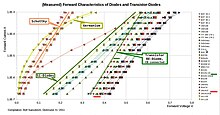1N4148 signal diode


The 1N4148 is a standard silicon switching signal diode. It is one of the most popular and long-lived switching diodes because of its dependable specifications and low cost. Its name follows the JEDEC nomenclature. The 1N4148 is useful in switching applications up to about 100 MHz with a reverse-recovery time of no more than 4 ns.
History[]
Texas Instruments announced the 1N914 diode in 1960.[1] It was registered at JEDEC by Texas Instruments no later than 1961, and was second-sourced by 11 manufacturers in 1961.[2]
The 1N4148 was registered at JEDEC in 1968 as a silicon switching signal diode for military and industrial applications.[3] It was second-sourced by many manufacturers; Texas Instruments listed their version of the device in an October 1966 data sheet.[4]
Today manufacturers produce the 1N4148 and sell it as the 1N914 too.[5] These device types have an enduring popularity in low-current applications.[6][7]
Overview[]

As the most common mass-produced switching diode, the 1N4148 replaced the older 1N914. They differed mainly in their leakage current specification, however, today most manufacturers list common specifications. For example, Vishay lists the same leakage current for both parts:[8][9]
- 25 nA at -20 V, 25°C
- 5 μA at -75 V, 25°C
- 50 μA at -20 V, 150°C
Packages[]
The JEDEC registered part numbers 1N914 and 1N4148 were originally only available in an axial package, but over time similar parts became available in surface-mount packages too.
- Through-hole package
- Surface-mount packages
- LL4148 in MiniMELF package.[12][14][15]
- 1N4148W in SOD-123 package.[16][17][18]
- 1N4148WS in SOD-323 package.[19][20][21]
- 1N4148WT in SOD-523 package.[22][23]
Note: Some 1N4148 family surface-mount packages are marked with "T4" text.[16][17]
Specifications[]

Absolute maximum ratings (stress ratings, consult datasheet for recommended ratings)[12]
- VRRM = 100 V (maximum repetitive reverse voltage)
- IO = 200 mA (average rectified forward current)
- IF = 300 mA (DC forward current)
- If = 400 mA (recurring peak forward current)
- IFSM = 1 A at 1 s pulse width; 4 A at 1 μs pulse width (non-repetitive peak forward surge current)
Electrical and thermal characteristics[12]
- VF = 1 V at 10 mA (maximum forward voltage)[24]
- VR = 75 V at 5 μA; 100 V at 100 μA (minimum breakdown voltage and reverse leakage current)
- trr = 4 ns (maximum reverse-recovery time)
- PD = 500 mW (maximum power dissipation)
See also[]
- 1N400x general-purpose diodes
- 1N58xx Schottky diodes
- Diode logic
References[]
- ^ "Texas Instruments 1N914 / 1N916 New Product Advertisement" (PDF). Electronic Industries magazine. March 1960. p. 201.
- ^ "Semiconductor Diode & Rectifier Characteristics Tabulation". Derivation and Tabulation Associates. April 1961. p. 209.
- ^ "Announcement of Electron Device Type Registration, Release No. 4443A". The Joint Electron Device Engineering Council. November 25, 1968. Retrieved May 15, 2021.
- ^ The Transistor and Diode Data Book, Texas Instruments Incorporated, publication no. CC-413 71243-73-CSS, no date, page 10-34
- ^ Michael Predko (2004). 123 robotics experiments for the evil genius. McGraw-Hill Professional. p. 93. ISBN 978-0-07-141358-9.
- ^ Jonathan Oxer; Hugh Blemings (2009). Practical Arduino: Cool Projects for Open Source Hardware. Apress. p. 10. ISBN 978-1-4302-2477-8.
Small "signal" diodes like the venerable 1N4148/1N914 can cope with about 200mA...
- ^ Michael Gasperi; Philippe E. Hurbain; Philippe Hurbain (2009). Extreme NXT: Extending the Lego Mindstorms NXT to the Next Level (2nd ed.). Apress. p. 211. ISBN 978-1-4302-2453-2.
You could use a 1N4002, but the 1N4148 is smaller and more appropriate for the current...
- ^ "1N914 Datasheet; DO-35 Package" (PDF). Vishay. February 2020. Archived (PDF) from the original on May 15, 2021.
- ^ a b "1N4148 Datasheet; DO-35 Package" (PDF). Vishay. July 2017. Archived (PDF) from the original on May 15, 2021.
- ^ "1N4148 / 1N4448 Datasheet; DO-35 Package" (PDF). Diodes Inc. May 2012. Archived (PDF) from the original on October 27, 2020.
- ^ "1N4148 Datasheet; DO-35 Package" (PDF). MCC. February 2013. Archived (PDF) from the original on May 15, 2021.
- ^ a b c d "1N4148 / 1N4448 / 1N914 / 1N916 Datasheet; DO-35 Package" (PDF). Fairchild. June 2015. Archived from the original (PDF) on November 1, 2017.
- ^ "1N4148 Datasheet; DO-35 Package" (PDF). Kingtronics. June 2015. Archived (PDF) from the original on October 1, 2020.
- ^ "LL4148 Datasheet; MiniMELF Package" (PDF). Kingtronics. June 2015. Archived (PDF) from the original on October 1, 2020.
- ^ "1N4148UR-1 Datasheet; MiniMELF Package". Microsemi. November 2012. Archived from the original on February 25, 2021.
- ^ a b "1N4148W / BAV16W Datasheet; SOD-123 Package" (PDF). Diodes Inc. January 2017. Archived (PDF) from the original on February 13, 2021.
- ^ a b "1N4148W Datasheet; SOD-123 Package" (PDF). MCC. March 2021. Archived (PDF) from the original on May 15, 2021.
- ^ "1N4148W Datasheet; SOD-123 Package" (PDF). Vishay. February 2018. Archived (PDF) from the original on May 15, 2021.
- ^ "1N4148WS / BAV16WS Datasheet; SOD-323 Package" (PDF). Diodes Inc. March 2016. Archived (PDF) from the original on September 22, 2020.
- ^ "1N4148WX Datasheet; SOD-323 Package" (PDF). MCC. December 2020. Archived (PDF) from the original on May 15, 2021.
- ^ "1N4148WS Datasheet; SOD-323 Package" (PDF). Vishay. July 2017. Archived (PDF) from the original on May 15, 2021.
- ^ "1N4148WT Datasheet; SOD-523 Package" (PDF). Diodes Inc. March 2018. Archived from the original (PDF) on September 1, 2020.
- ^ "1N4148X Datasheet; SOD-523 Package" (PDF). MCC. December 2020. Archived (PDF) from the original on May 15, 2021.
- ^ "1". The Semiconctor Data Library (Fourth ed.). Motorola Semiconductor Products, Inc. 1973. p. 73.
Further reading[]
- Historical databooks
- Transistor and Diode Data Book (1973, 1236 pages), Texas Instruments
- Diode Data Book (1978, 210 pages), Fairchild
- Rectifiers and Zener Diodes Data Book (1988, 508 pages), Motorola
- Rectifier Device Data Book (1995, 410 pages), Motorola
External links[]
| Wikimedia Commons has media related to |
- Diodes